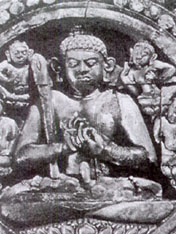 |
|
The
club bearing Lakulisha, founder of the esoteric Pashupata sect around
200 A.D., said to be Shiva himself who entered a corpse and brought
it to life
|
Shiva soon became the inspiration for theatre, drama and dance. He became the favourite icon of painters and sculptors. He was the adaptable manifestation of the divine. No wonder, various folk deities, like Khandoba in the Deccan and Ayyappa in the south, came to be seen as local manifestations of Shiva and were soon assimilated into the Shaivite fold. Even Shankaracharya, reviver of Vedantic philosophy, in the 8th century A.D., saw Shiva representation of the impersonal mystery, the Saguna Brahman.
Vishnu, the darling of the Brahmanical order, complemented Shiva. He was the solar god, the saviour, a conformist. The fierce animosity between the Vaishnavites and the Shaivites has been long documented in myth and history. But such sectarianism was merely a product of ignorance, egoism and delusions. The wise had always expressions of the same godhead.
Shaivism faced its greatest threat when India came to be ruled by the followers of Mohammed. The Muslim masters of India earnestly believed that the glory of godhead cannot be confined to an idol: any attempt to do so was blasphemous. Their faith led them to destroy many Shaivite shrines like the temples at Somnath and kashi.
But Shiva survived the desecration of his shrines. Even today he captures our imagination, excites, inspired and fills us with awe, just as he did 5000 years ago.
The history of Shaivism tells us that the realization of Shiva has been attained in various ways: from primitive tribal shamanism through heretic covens to sophisticated Brahmanical philosophies. This is not surprising, for Shiva has never been a parochial divinity; he is a cosmic entity, a holy grail in the soul's quest for freedom and ecstasy.